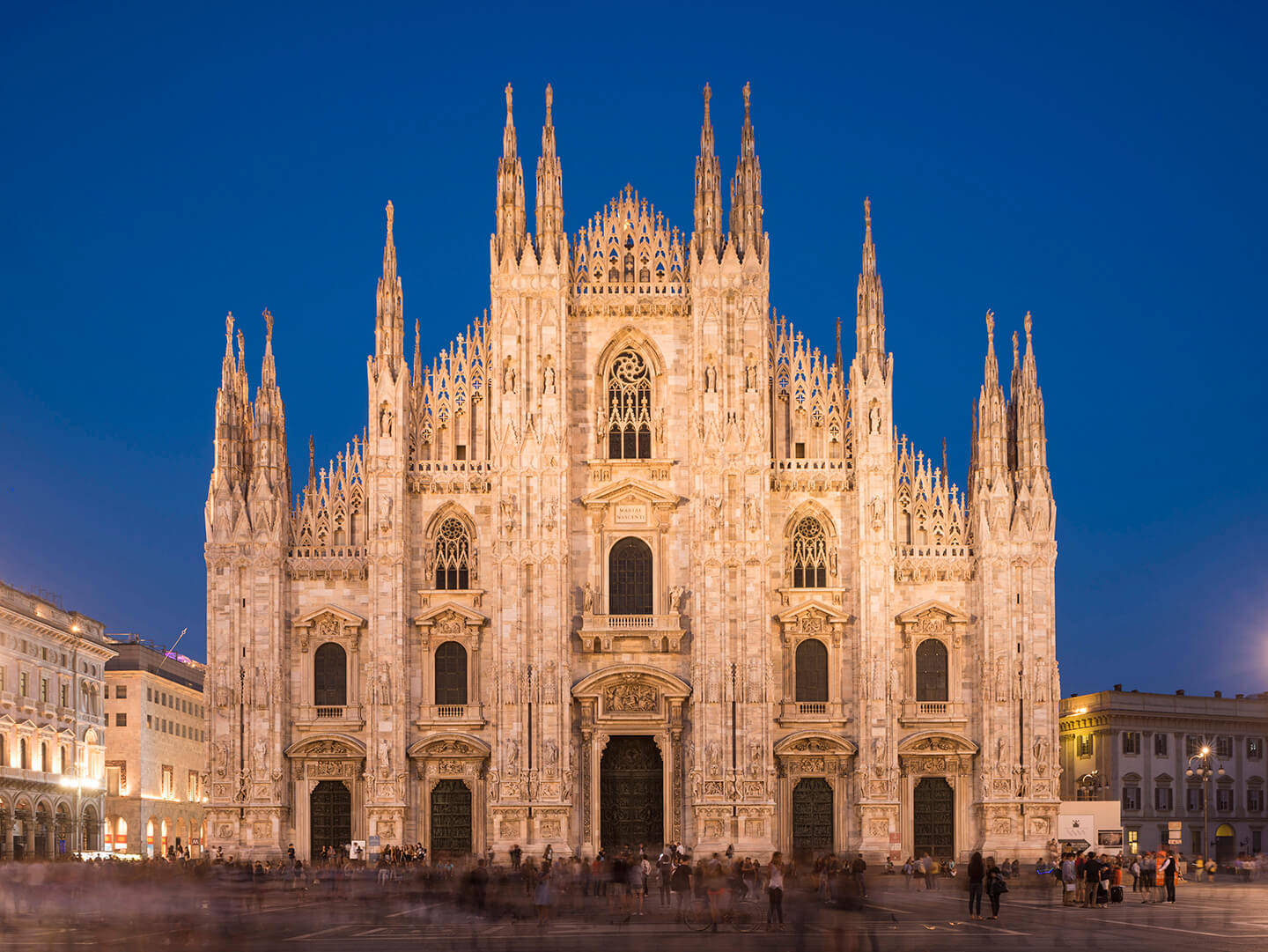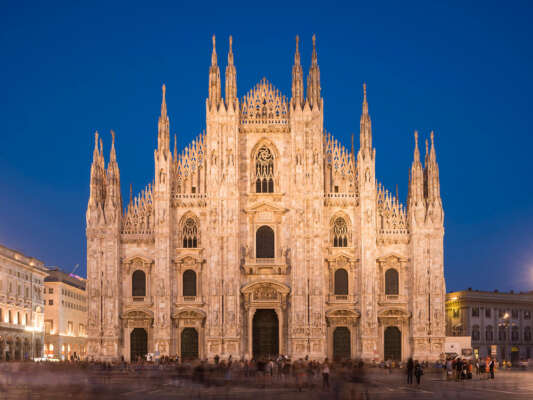The Milan Cathedral, known as the Duomo, is the main cathedral in Milan, Italy. It is the biggest church in Italy. The Gothic cathedral took around 600 years to build and complete. Today, it is one of the main tourist attractions in Milan.
Milan’s Cathedral – Free Guide
Editor’s Choice
Before the Duomo, there were 2 churches on this spot – the Basilica of St. Thecla and the old octagonal baptistery. But both were damaged in a big fire. Centuries later, they were rebuilt into the present-day Duomo.
In 1386, Archbishop Antonio da Saluzzo started construction of the cathedral. This coincided with Gian Galeazzo Visconti gaining power in Milan. It was meant as a gift to the nobility and working class, who had suffered under Visconti’s tyrannical predecessor.
Galeazzo collected large donations for the construction and strictly regulated the “Fabbrica del Duomo” which had around 300 workers led by chief engineer Simone da Orsenigo. He originally planned to build the cathedral from brick in Gothic style.
16 years later in 1402, almost half of the cathedral was done. After 66 years in 1452, the nave and aisles were finished up to the sixth bay. But by 1480 construction had mostly halted due to insufficient funds and ideas.
In 1488, Leonardo da Vinci and Donato Bramante made models in a contest to design the central dome. Da Vinci later withdrew. From 1500 to 1510 under Ludovico Sforza, the octagonal dome was finished and decorated inside with statues of saints, prophets, sibyls and biblical figures. The exterior had no ornaments yet. But the church was usable.
In the 1580s under Archbishop Carlo Borromeo and chief engineer Pellegrino Pellegrini, the cathedral began getting its Renaissance design which would highlight its Roman/Italian nature, and reduce the Gothic style, now seen as foreign.
But in the 1600s, architect Carlo Buzzi made a bold change – the façade would revert to original Gothic including details within giant Gothic pillars and two huge belfries.
In 1682 the cathedral roof was completed.
In 1762 one of the Duomo’s main features, the Madonnina spire, was built to a height of 108.5 meters by Carlo Pellicani, topped by a polychrome Madonnina statue designed by Giuseppe Perego.
In 1805, Napoleon Bonaparte ordered the façade finished before being crowned King of Italy in the Duomo. It got some neo-Gothic windows. A statue of Napoleon was placed atop a spire in thanks.
Bombings in World War 2 delayed construction again. The Duomo was damaged but less than other major buildings. It quickly became a gathering spot for displaced locals.
The final touches were completed in the 1900s – the last portal opened in 1965.
Now let’s discuss what you can see at the Duomo.
The cathedral is 158.6 meters long and 92 meters wide. It covers about 11,700 square meters, equal to nearly 2 football fields.
You can buy entrance tickets on the official website for the cathedral, terraces, tours, museum, archaeological area, and augmented reality experience.
The floor plan has a nave with 4 aisles, crossed by a transept, then a choir and apse. The nave height is around 45 meters.
The roof has spectacular sculptures best seen up close. The roof is renowned for its openwork spires and pinnacles, on delicate flying buttresses.
The 5 broad naves, split by 40 pillars, are reflected in the façade’s hierarchical openings. Even the transepts have aisles. The columns are 24.5 meters high. The apsidal windows are 20.7 by 8.5 meters. The brick structure is faced with marble. Maintenance is very complex.
In 2015, LED lights were installed for impressive nighttime viewing.
Reactions to the cathedral have ranged from high praise to strong dislike and back, as architectural styles changed. Early Romantics admired its “first intense enthusiasms for Gothic”. But as purer Gothic tastes emerged, condemnation was often equally intense.
The cathedral interior has many monuments and artworks.
The main altar is at the eastern end of the nave – the focal point of the interior. It exemplifies Gothic design with intricate carvings, sculptures and gold leaf decorations. It is where the Eucharist is consecrated during Mass.
Above the altar is the Holy Nail from the True Cross, kept here since 1461. Visitors can see its red light high on the ceiling. The “Nivola”, a decorated cloud-shaped lift, accesses the reliquary. In September the Nail is lowered and displayed on a giant wooden cross. After 2 days it’s replaced in its tabernacle watching over the altar and cathedral.
Left of the altar is Marco d’Agrate’s famous statue of Saint Bartholomew Flayed, holding his flayed skin like a stole.
Throughout are archbishops’ sarcophagi, saints’ altars, and decorated monuments.
The Duomo has Italy’s largest pipe organ, built in 1938 on Mussolini’s orders.
Near the entrance is a brass sundial strip crossing the nave, projecting a ray of light at noon to mark the date. It was made by 18th century astronomers.
Some beautiful Renaissance stained glass windows depict biblical and saintly scenes in fine detail and elegant costumes.
In the rear choir, stairs lead down to the crypt. First you pass through a 1820s vestibule to the circular San Carlo chapel with red marble columns supporting the vault.
From the vestibule a staircase accesses the 4th century basement with remains of the old baptistery and Santa Tecla basilica.
An elevator in the northern transept reaches the terraces, offering extraordinary city views and see the cathedral’s statues and details up close.
The 1774 Madonnina statue tops the cathedral at 108.5 meters. Designed by Giuseppe Perego and cast by Giuseppe Bini, it is 4.16 meters tall with a metal skeleton, now replaced by steel. The Madonnina is a religious symbol, city guardian, architectural feature, and formerly helped set clocks. Its halo has a lightning rod to protect the cathedral.
Some key tips and takeaways:
The Duomo is a stunning Gothic cathedral and Italy’s largest church.
It is an iconic Milan landmark and cultural symbol.
The cathedral has a rich 600 year history.
The interior features exquisite artwork – stained glass, sculptures, etc.
Visit the crypt for insight into the Duomo’s history.
Climb the roof for panoramic city views.
The Duomo is located in central Milan near other attractions.
Dress modestly and be respectful as it is an active place of worship.
Purchase tickets online in advance to avoid long lines.




